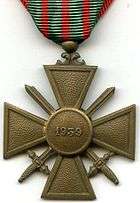Croix de guerre 1939–1945 (France)
| Croix de guerre 1939–1945 | |
|---|---|
|
1939–1945 War Cross with 2 gilt stars | |
|
Awarded by | |
| Type | Bravery award |
| Awarded for | Military duty during World War II mentioned in dispatches |
| Status | No longer awarded |
| Clasps |
silver gilt palm silver palm bronze palm gilt star silver star bronze star |
| Statistics | |
| Established | September 26, 1939 |
| Precedence | |
| Next (higher) | Croix de guerre 1914–1918 |
| Next (lower) | Croix de guerre des TOE |
|
Ribbon bar & streamer of the French Croix de guerre 1939–1945 | |

The Croix de guerre 1939–1945 (War Cross 1939–1945) is a French military decoration, a version of the Croix de guerre created on September 26, 1939, to honour people who fought with the Allies against the Axis forces at any time during World War II.
Award statute
Due to the large extent of the war zone, recipients included various groups:[1]
- those who fought during the Battle of France
- those who fought with the French Forces of the Interior
- those who fought with the Free French Forces
- those who fought on the Western Front,
- those who fought in the Middle East Theater
- those who fought in the Mediterranean Theater
- those who fought in the African campaigns
On every Croix de guerre, there is at least one ribbon device, either in the shape of a palm or of a star, and fashioned from either bronze, silver or gilded silver. The relative importance of the six possible combinations is detailed below. The total number of devices on a "Croix de guerre" is not limited.
Award description
- Medal
- The medal was designed by the sculptor Paul-Albert Bartholomé. It is 37 mm in size and is in the shape of a Maltese cross with two swords criss-crossed through the center. In the center of the front, is the profile of the French Republic crested by a Phrygian cap. Around this portrait, are the words République française ("French Republic"). On the reverse of the medal are the dates of the conflict : 1939–1940, 1939–1945, or simply 1940.[1]
- Ribbon
- red background crossed with four green lines in its center.[2]
Award grades
- Mentioned in Despatches : the lowest degree is represented by a bronze star while the highest degree is represented by a bronze palm:[2]
- a bronze star (étoile en bronze) for those who had been mentioned at the regiment or brigade level.
- a silver star (étoile en argent), for those who had been mentioned at the division level.
- a silver-gilt star (étoile en vermeil), for those who had been mentioned at the corps level.
- a bronze palm (palme en bronze), for those who had been mentioned at the army level.
- a silver palm (palme en argent), represents five bronze ones.
- a silver-gilt palm (palme en vermeil), for those who had been mentioned at the Free French Forces level (World War II only).[1]
The clasps are awarded for gallantry to any member of the French military or its allies and are, depending on the degree, roughly the equivalent for U.S. Bronze Star and Silver Star or UK Military Cross and Military Medal.
See also
- Ribbons of the French military and civil awards
- Croix de guerre 1914–1918
- Croix de guerre des Théatres d'Opérations Exterieures
- Croix de guerre (Belgium)
References
- 1 2 3 Marc Champenois. "Croix de guerre 1939–1945" (in French). France-phaleristique.com. Retrieved 1 November 2013.
- 1 2 "Croix De Guerre, France". The Institute of Heraldry. Retrieved 2 November 2013.
